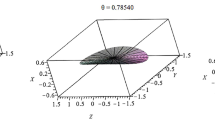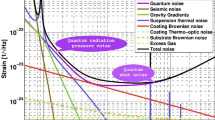Summary
We investigate the physical meaning of the observers (defined in a geometrical, coordinate-independent way) associated with the TT gauge and otherad hoc coordinate systems that are often used in the description of gravitational-wave detectors. TT observers undergo very complicated motions when seen by a freely falling observer; for most (but not all) kinds of detectors with sizel much smaller than the wavelength λ of the radiation to be detected, Fermi normal coordinates are the best. For detectors withl/λ≥1, there are tricky possibilities depending on the particular kind of device considered; we point out the difficulty of giving a clear, geometrical description of the family of fundamental observers associated with the detector.
Similar content being viewed by others
References
P. L. Fortini andC. Gualdi:Nuovo Cimento B,71, 37, (1982).
L. Baroni et al.: Proceedings of the Fourth Marcel Grossman Meeting on General Relativity, edited byR. Ruffini (Elsevier Science Publishers B. V., 1986).
G. Flores andM. Orlandini:Nuovo Cimento B,91, 236 (1986).
R. M. Wald:General Relativity (The University of Chicago Press, Chicago, Ill., 1984).
V. Faraoni:Phys. Lett. A,153, 67 (1991).
F. K. Manasse andC. W. Misner:J. Math. Phys.,4, 735 (1963).
C. W. Misner, K. S. Thorne andJ. A. Wheeler:Gravitation (Freeman, San Francisco, Cal., 1973), p. 327.
W. T. Ni andM. Zimmermann:Phys. Rev. D,17, 1473 (1978).
K. S. Thorne: inGravitational Radiation, edited byN. Deruelle andT. Piran (North Holland, 1983), p. 49.
M. Carmeli:Classical Fields: General Relativity and Gauge Theory (Wiley, New York, N.Y., 1982), p. 151.
F. I. Cooperstock:Ann. Phys.,47, 173 (1968).
L. Baroni, P. Fortini andC. Gualdi:Ann. Phys.,162, 49 (1985).
V. B. Braginsky et al.:Sov. Phys. JETP,38, 865 (1974).
C. M. Caves:Phys. Lett. B,80, 323 (1979).
L. P. Grishuck:Proceedings of the Ninth International Conference on General Relativity and Gravitation, edited byE. Schmutzer (Cambridge University Press, Cambridge, 1983), p. 255.
F. Pegoraro andL. A. Radicati:J. Phys. A,13, 2411 (1980).
L. P. Grishchuk andA. G. Polnarev: inGeneral Relativity and Gravitation, edited byA. Held, Vol. 2 (Plenum Press, New York, N.Y., 1981), p. 393.
L. D. Landau andE. M. Lifshitz:The Classical Theory of Field (Pergamon Press, Oxford, 1962).
E. M. Lifshitz andI. Kalatnikov:Sov. Phys. Usp.,6, 495 (1964).
Author information
Authors and Affiliations
Additional information
The author of this paper has agreed to not receive the proofs for correction.
Rights and permissions
About this article
Cite this article
Faraoni, V. Theoretical problems on gravitational-wave detectors. Nuov Cim B 107, 631–642 (1992). https://doi.org/10.1007/BF02723171
Received:
Accepted:
Published:
Issue Date:
DOI: https://doi.org/10.1007/BF02723171




